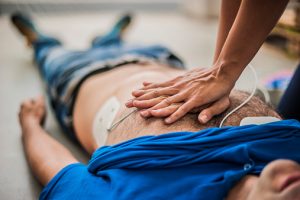 In a bid to improve the survival rates for people who suffer cardiac arrest outside a hospital, emergency physicians, led by lead author Bentley J. Bobrow, MD, propose three interventions. Dr. Bobrow is a professor of emergency medicine at the University Of Arizona College Of Medicine in Tucson and Medical Director for the Bureau of EMS and Trauma System in Arizona.
In a bid to improve the survival rates for people who suffer cardiac arrest outside a hospital, emergency physicians, led by lead author Bentley J. Bobrow, MD, propose three interventions. Dr. Bobrow is a professor of emergency medicine at the University Of Arizona College Of Medicine in Tucson and Medical Director for the Bureau of EMS and Trauma System in Arizona.
The findings of the team, and their suggestions are published online last Wednesday in Annals of Emergency Medicine along with an appeal to the authorities to increase federal funding for cardiac resuscitation research.
Advertisement
Currently the chances of survival for people suffering a cardiac arrest outside a hospital are very low – 6% to be precise – and the emergency physicians believe these three easy steps can improve survival rates and functional outcomes in any community.
According to Dr. Bobrow, “As a nation, we are falling far short in our efforts to improve survival for this exquisitely time-sensitive medical emergency,”
Dr. Bobrow believes the tools to increase the survival rates are readily available and emergency physicians are uniquely positioned to lead this effort.
The Institute of Medicine for optimizing cardiac arrest care has recently issued a set of recommendations to improve the chances of survival. Based on their recommendations Dr. Bobrow and his team propose three concrete steps that can be followed to help improve survival from out-of-hospital cardiac arrest.
The three steps are:
1. Develop a nation-wide registry that reports OHCA incidence accurately. The report should also highlight the process of care measures and the patient outcomes in a standardized format.
2. Encourage bystander cardiopulmonary resuscitation (CPR) through education and training. This includes training of 9-1-1 operators to guide bystanders through CPR procedures with clear, easy-to-follow instructions that are standardized.
3. Increase the availability and use of high-performance CPR by medical professionals. This can be done by measuring the quality of CPR currently being applied during resuscitations and continuously improving it.
Advertisement
The published article also points out that a significant problem is the poor research funding for cardiac resuscitation.
According to Dr. Bobrow, between 1985 and 2009, there were 294 federally-funded studies per 10,000 deaths per year for stroke but there were only eight studies for cardiac resuscitation. This has to change. Funding for cardiac resuscitation research must be a national public health priority.
The team also feels that public underestimation of the dangers of cardiac arrest could be one of the reasons for the low survival rates. Additional funds can help in educating the public and taking baby steps in the right direction to increase cardiac arrest survival rates.
